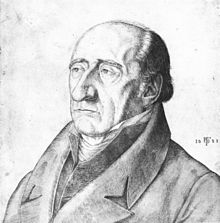Friedrich von Olivier

Woldemar Friedrich von Olivier (born April 23, 1791 in Dessau , † September 5, 1859 in Dessau) was a German Romantic painter .
Life
Friedrich Olivier was the son of the pedagogue Prof. Ferdinand Olivier the Elder. Ä. and his wife, the opera singer Louise Neidhart. The painters Ferdinand Olivier and Heinrich Olivier were his brothers.
Like his brothers, Friedrich Olivier also enjoyed his first artistic lessons from Karl Wilhelm Kolbe and Christian Haldenwang between 1801 and 1802 . In addition, he became a student of the court sculptor Friedemann Hunold in Dessau .
After his brothers were back from Paris , Friedrich accompanied his brother Ferdinand on his trip to the Harz Mountains and went to Vienna with him in 1811 . There he attended the Academy of Fine Arts . After his brother Ferdinand married the widow Margret Heller, he gave up his household and moved in with them.
After the wars of freedom began , Friedrich Olivier hiked with Theodor Körner from Vienna to Breslau . Their goal was the Lützow Freikorps , which they joined as a volunteer. After several assignments in the Netherlands and France, Olivier visited Great Britain for a short time.
In 1814 Friedrich Olivier returned to his brother Ferdinand in Vienna . Three years later he accompanied him on his second trip through the Salzburg region . Also on board were colleagues Philipp Veit , Carl Ludwig Frommel , Johann Christian Rist and Julius Schnorr von Carolsfeld .

On November 12, 1818 Olivier went to Italy with Carl Schmidt and Julius Schnorr von Carolsfeld . During a longer stay in Florence , Olivier made the acquaintance of the art-loving Baron Karl Friedrich von Rumohr . In Rome , Olivier and Schnorr von Carolsfeld soon made contact with Johann David Passavant , Friedrich Overbeck , Peter von Cornelius , Wilhelm von Schadow and Johannes Veit . Together with Theodor Rehbenitz , they lived in the Palazzo Caffarelli with the Prussian ambassador Christian Karl Josias Freiherr von Bunsen .
Friedrich Olivier also met Freiherr vom Stein through Schnorr von Carolsfeld in Rome . On behalf of the Naumburg canon Immanuel Christian Leberecht von Ampach , the painting Christ and the Pharisees Advising on the Tribute , also known as Christ with the interest penny , was created after 1820 for the Christ cycle in Naumburg Cathedral . After four years, Friedrich Olivier returned to Vienna in 1823 to see his brother. In 1825 Olivier married Fanny Heller, a stepdaughter of his brother Ferdinand, there. During his stay in Vienna, Friedrich Olivier changed his painting style in such a way that he can almost be considered the predecessor of Hans von Marées .
Olivier went to Munich and with the permission of King Ludwig I became an assistant to Julius Schnorr von Carolsfeld. He had a major job to do in the residence.
When Friedrich Olivier's brother Heinrich died on March 3, 1848 , he went back to his hometown. He took over his parents' house and lived and worked there until the end of his life.
Friedrich Olivier died on September 5th, 1859 in Dessau at the age of 68.
When the Glass Palace in Munich burned on June 6, 1931, several of the works he exhibited there perished, including the “Visitation of Mary” and “Bavarian Landscape”.
literature
- Constantin von Wurzbach : O'Livier, artist family . In: Biographisches Lexikon des Kaiserthums Oesterreich . 21st part. Imperial-Royal Court and State Printing Office, Vienna 1870, p. 57 f. ( Digitized version ).
- Franz Schnorr von Carolsfeld : Olivier, Ferdinand von . In: Allgemeine Deutsche Biographie (ADB). Volume 24, Duncker & Humblot, Leipzig 1887, pp. 308-311. (Family item)
- Helga Heise: Olivier, from. In: New German Biography (NDB). Volume 19, Duncker & Humblot, Berlin 1999, ISBN 3-428-00200-8 , p. 523 f. ( Digitized version ).
Web links
- Literature by and about Friedrich von Olivier in the catalog of the German National Library
- Works by Friedrich von Olivier at Zeno.org .
- Entry on Friedrich von Olivier in the Austria Forum (in the AEIOU Austria Lexicon )
Individual evidence
- ↑ Helga Heise: Olivier, from. In: New German Biography (NDB). Volume 19, Duncker & Humblot, Berlin 1999, ISBN 3-428-00200-8 , p. 523 f. ( Digitized version ).
| personal data | |
|---|---|
| SURNAME | Olivier, Friedrich von |
| ALTERNATIVE NAMES | Olivier, Friedrich; Olivier, Woldemar Friedrich von |
| BRIEF DESCRIPTION | German painter |
| DATE OF BIRTH | April 23, 1791 |
| PLACE OF BIRTH | Dessau |
| DATE OF DEATH | September 5, 1859 |
| Place of death | Dessau |
